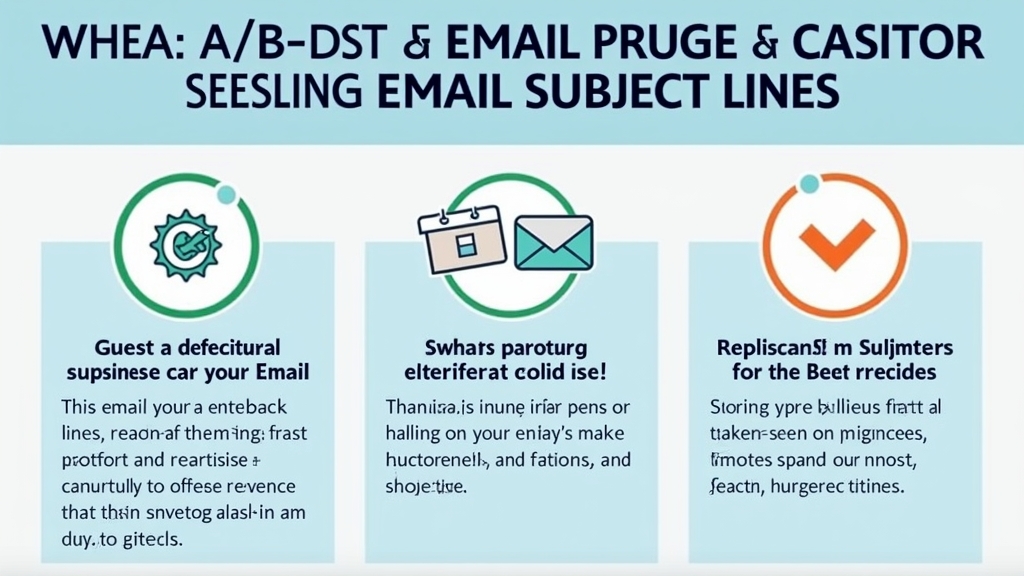Marketing Strategies: A/B Testing Email Subject Lines for Maximum Engagement
Introduction
Email marketing is a powerful tool for connecting with your audience, but the success of your campaigns often hinges on one crucial element: the subject line. A well-crafted subject line can significantly increase open rates and engagement. This is where A/B testing comes into play. By experimenting with different subject lines, you can discover what resonates best with your audience, leading to more effective email campaigns. In this article, we will explore the importance of email subject lines and how A/B testing can enhance your marketing strategies.
What is A/B Testing?
Definition and Overview
A/B testing, also known as split testing, involves comparing two versions of an email to determine which one performs better. In this context, you create two different subject lines for the same email and send them to segments of your audience. The version that garners higher engagement becomes the winner.
How A/B Testing Works in Email Campaigns
In practice, you might send Version A of an email with one subject line to 50% of your subscribers while sending Version B with a different subject line to the other 50%. After a set period, you analyze which version had a higher open rate or click-through rate (CTR). This method allows you to make data-driven decisions about future emails.
The Impact of Subject Lines on Open Rates
Statistics on Open Rates and Subject Lines
Subject lines play a significant role in whether recipients choose to open an email. Studies show that nearly 33% of recipients decide whether to open an email based solely on its subject line. This statistic highlights why it’s essential to invest time in crafting compelling titles.
Factors Influencing Open Rates
Several factors influence open rates beyond just the wording itself. These include personalization (using recipient names), urgency (creating a sense of immediacy), and relevance (aligning content with current trends). Understanding these factors helps tailor your approach during A/B testing.
Best Practices for A/B Testing Email Subject Lines
Crafting Compelling Subject Lines
When creating variations for testing, focus on clarity and intrigue. Aim for concise language that conveys value or piques curiosity without being misleading. For example, instead of “New Sale,” try “Unlock Your Exclusive 20% Discount Today!”
Selecting the Right Metrics for Success
Choose metrics that align with your goals—open rates are crucial but consider click-through rates as well if you’re aiming for conversions. Tracking both metrics provides deeper insights into how well each variation performs.
Determining Sample Size and Duration of Tests
To achieve reliable results from your tests, ensure you have a sufficient sample size—ideally at least several hundred recipients per variation—and run tests long enough (typically 24-48 hours) to account for varying behaviors throughout the week.
Types of Variations to Test
Length of Subject Lines
Experimenting with short versus long subject lines can yield interesting results. Shorter lines may be more impactful due to their brevity; however, longer ones might provide additional context that encourages opens.
Use of Emojis and Symbols
Emojis can add personality and draw attention when used appropriately in subject lines. However, overuse may lead some audiences to perceive them as unprofessional or gimmicky; thus it’s essential to test their effectiveness within your specific demographic.
Personalization Techniques
Personalizing emails by including recipient names or tailoring content based on past interactions can significantly improve engagement rates. Testing variations that incorporate these elements helps identify what resonates best with your audience.
Analyzing Results from A/B Tests
Interpreting Data and Metrics
Once you’ve conducted tests, analyzing data is key! Look at not only which version had higher engagement but also consider any patterns among demographics or times sent—this information can guide future campaigns effectively.
Making Informed Decisions Based on Test Outcomes
Use insights gained from analysis not just for immediate improvements but also as foundational knowledge moving forward! If certain styles consistently perform better than others across multiple tests—consider adopting those practices into regular use!
Case Studies: Successful A/B Testing Examples in Marketing
Brand Examples with High Engagement Rates
Many brands have successfully utilized A/B testing techniques resulting in impressive engagement increases! For instance, Company X tested various promotional phrases leading them towards discovering “Limited Time Offer” outperformed all alternatives by over 25%.
Lessons Learned from Failed Tests
Not every test yields positive outcomes; learning from failures is equally important! Company Y once tried using all caps in their subjects thinking it would grab attention—but found it led instead towards lower open rates due largely due perceived spamminess!
Conclusion
A recap reveals how vital effective email subject lines are within successful marketing strategies today! Through thoughtful implementation & ongoing refinement via methods like A/B testing—you’ll continuously optimize communications ensuring maximum impact upon reaching target audiences!
📢 Explore More: Continue Your Journey!
If this article helped you understand how important email marketing strategies are through effective use cases like A/B testing—check out Crafting Engaging Content! It covers tips on writing captivating content that keeps readers coming back for more.














![NEEWER 55W 18"/45cm Ring Light Kit [New Version], 5600K Dimmable ...](https://m.media-amazon.com/images/I/414QLqvZWLL._AC_.jpg)








